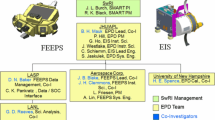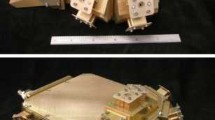Abstract
Amongst its complement of particles and fields instruments, the Galileo spacecraft carries an Energetic Particles Detector (EPD) designed to measure the characteristics of particle populations important in determining the size, shape, and dynamics of the Jovian magnetosphere. To do this the EPD provides 4π angular coverage and spectral measurements for Z ≥ 1 ions from 20 keV to 55 MeV, for electrons from 15 keV to > 11 MeV, and for the elemental species helium through iron from approximately 10 keV nucl-1 to 15 MeV nucl-1. Two bi-directional telescopes, mounted on a stepping platform, employ magnetic deflection, energy loss versus energy, and time-of-flight techniques to provide 64 rate channels and pulse height analysis of priority selected events. The EPD data system provides a large number of possible operational modes from which a small number will be selected to optimize data collection during the many encounter and cruise phases of the mission. The EPD employs a number of safeing algorithms that are to be used in the event that its self-checking procedures indicate a problem. The EPD has demonstrated its operational flexibility throughout the long evolution of the Galileo program by readily accommodating a variety of secondary mission objectives occasioned by the changing mission profile, such as the Venus flyby and the Earth 1 and 2 encounters. To date the EPD performance in flight has been nominal. In this paper we describe the instrument and its operation.
Similar content being viewed by others
References
Fort, D. E.: 1985, JHU/APL Space Systems Report CP087.
Gehrels, N. and Stone, E. C.: 1983, J. Geophys. Res., 88, 5537.
Gloeckler, G., Geiss, J., Balsiger, H., Fisk, L. A., Gliem, G., Ipavich, F. M., Ogilvie, K. W., Stüdemann, W., and Wilken, B.: 1983, ESA SP-1050, 75.
Gloeckler, G., Ipavich, F. M., Stüdemann, W., Wilken, B., Hamilton, D. C., Kremser, G., Hovestadt, D., Gliem, F., Lundgren, R. A., Rieck, W., Tums, E. O., Cain, J. C., Masung, L. S., Weiss, W., and Winterhof, P.: 1985, IEEE Trans. Geosci. Remote Sensing GE-23, 234.
Krimigis, S. M. and Roelof, E. C.: 1983, in A. J. Dessler (ed.), Physics of the Jovian Magnetosphere, Cambridge University Press, Cambridge, p. 106.
Mauk, B. H. and Krimigis, S. M.: 1987, J. Geophys. Res. 92, 9931.
McEntire, R. W., Keath, E. P., Fort, D., Lui, A. T. Y., and Krimigis, S. M.: 1985, IEEE Trans. Geosci. Remote Sensing GE-23, 230.
Stüdemann, W. and Wilken, B.: 1982, Rev. Sci. Instr. 53.
Stüdemann, W. and Wilken, B., Kremser, G., Korth, A., Fennell, J. F., Blake, B., Koga, R., Hall, D., Bryant, D., Soraas, F., Bronstad, K., Fritz, T. A., Lundin, R., and Gloeckler, G.: 1987, Geophys. Res. Letters 14, 455.
Wilken, B. and Stüdemann, W.: 1984, Nuc. Inst. Methods 22, 587.
Wilken, B., Weiss, W., Stüdemann, W., and Hasebe, H.: 1987, J. Phys. E: Sci. Inst. 20.
Wu, Y. and Armstrong, T. P.: 1988, Nucl. Instr. Methods Phys. Res. A265, 561.
Author information
Authors and Affiliations
Rights and permissions
About this article
Cite this article
Williams, D.J., McEntire, R.W., Jaskulek, S. et al. The Galileo Energetic Particles Detector. Space Sci Rev 60, 385–412 (1992). https://doi.org/10.1007/BF00216863
Issue Date:
DOI: https://doi.org/10.1007/BF00216863




